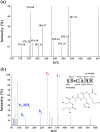Antioxidant activity of SSeCAHK in HepG2 cells: a selenopeptide identified from selenium-enriched soybean protein hydrolysates
- PMID: 35497303
- PMCID: PMC9042330
- DOI: 10.1039/d1ra06539d
Antioxidant activity of SSeCAHK in HepG2 cells: a selenopeptide identified from selenium-enriched soybean protein hydrolysates
Abstract
This paper is aimed at purifying and identifying selenium (Se)-containing antioxidative peptides from Se-enriched soybean peptides (SSP). In this work, the SSP was separated into five fractions (F1 to F5). Fraction F4, displaying the highest antioxidative activity, was further separated, and sub-fractions F4-1 to F4-5 were selected for antioxidative activity evaluation using 1,1-diphenyl-2-picrylhydrazyl (DPPH), 2,2-azino-bis-(3-ethylbenzo-thiazoline-6-sulphonic acid)diammonium salt (ABTS), and OH- radical scavenging assays. The Se-containing antioxidative peptides with sequence Ser-SeC-Ala-His-Lys (SSeCAHK) were identified in sub-fraction F4-1 and chemically synthesized. This Se-containing pentapeptide showed a preventive effect against hydrogen peroxide (H2O2)-induced oxidative stress in HepG2 cells. Pretreating the cells for 2 h with SSeCAHK (0.13-0.50 mg mL-1) induced strong intracellular, reactive oxygen species (ROS) scavenging activity while preventing a decrease in reduced glutathione (GSH) and an increase in malondialdehyde (MDA). Therefore, SSeCAHK treatment improved H2O2-induced oxidative stress in HepG2 cells, demonstrating the significant potential of SSeCAHK as a natural antioxidative functional material for dietary supplementation.
This journal is © The Royal Society of Chemistry.
Conflict of interest statement
There are no conflicts to declare.
Figures






Similar articles
-
Antioxidant Peptides from the Protein Hydrolysate of Monkfish (Lophius litulon) Muscle: Purification, Identification, and Cytoprotective Function on HepG2 Cells Damage by H2O2.Mar Drugs. 2020 Mar 10;18(3):153. doi: 10.3390/md18030153. Mar Drugs. 2020. PMID: 32164197 Free PMC article.
-
Purification and identification of Se-containing antioxidative peptides from enzymatic hydrolysates of Se-enriched brown rice protein.Food Chem. 2015 Nov 15;187:424-30. doi: 10.1016/j.foodchem.2015.04.086. Epub 2015 Apr 24. Food Chem. 2015. PMID: 25977046
-
Purification and identification of novel antioxidant peptides from watermelon seed protein hydrolysates and their cytoprotective effects on H2O2-induced oxidative stress.Food Chem. 2020 Oct 15;327:127059. doi: 10.1016/j.foodchem.2020.127059. Epub 2020 May 15. Food Chem. 2020. PMID: 32447138
-
Selenium-enriched peptides identified from selenium-enriched soybean protein hydrolysate: protective effects against heat damage in Caco-2 cells.Food Funct. 2023 Aug 29;14(17):7882-7896. doi: 10.1039/d3fo01103h. Food Funct. 2023. PMID: 37489104
-
Antioxidant Activity of Selenium-Enriched Peptides from the Protein Hydrolysate of Cardamine violifolia.J Food Sci. 2019 Dec;84(12):3504-3511. doi: 10.1111/1750-3841.14843. Epub 2019 Oct 30. J Food Sci. 2019. PMID: 31665556
Cited by
-
Investigation of the effects of catharanthine and Q10 on Nrf2 and its association with MMP-9, MRP1, and Bcl-2 and apoptosis in a model of hepatocellular carcinoma.Naunyn Schmiedebergs Arch Pharmacol. 2024 Apr;397(4):2507-2522. doi: 10.1007/s00210-023-02767-0. Epub 2023 Oct 19. Naunyn Schmiedebergs Arch Pharmacol. 2024. PMID: 37855932
-
Mitigation of Paeoniae Radix Alba extracts on H2O2-induced oxidative damage in HepG2 cells and hyperglycemia in zebrafish, and identification of phytochemical constituents.Front Nutr. 2023 Feb 23;10:1135759. doi: 10.3389/fnut.2023.1135759. eCollection 2023. Front Nutr. 2023. PMID: 36908919 Free PMC article.
-
Proton-coupled electron transfer of catechin in tea wine: the enhanced mechanism of anti-oxidative capacity.RSC Adv. 2021 Dec 15;11(63):39985-39993. doi: 10.1039/d1ra07769d. eCollection 2021 Dec 13. RSC Adv. 2021. PMID: 35494161 Free PMC article.
-
Selenium-Enriched Soybean Peptides as Novel Organic Selenium Compound Supplements: Inhibition of Occupational Air Pollution Exposure-Induced Apoptosis in Lung Epithelial Cells.Nutrients. 2023 Dec 25;16(1):71. doi: 10.3390/nu16010071. Nutrients. 2023. PMID: 38201901 Free PMC article.
References
LinkOut - more resources
Full Text Sources
Miscellaneous

